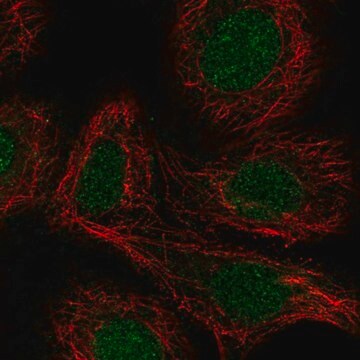Pochodzenie linii komórkowej
Przerzuty do szpiku kostnego ludzkiego neuroblastoma
Opis linii komórkowej
Wyhodowany przez Seegera i wsp. (1977) z komórek neuroblastomy w szpiku kostnym 2-letniego mężczyzny z neuroblastomą w IV stadium klinicznym. Komórki są neuroblastyczne, w kształcie łzy z wieloma krótkimi, drobnymi wyrostkami komórkowymi (neurytami). Komórki są nowotworotwórcze u nagich myszy. Jest to linia komórkowa neuroblastoma wytwarzająca katecholaminy. Wykazano, że LA-N-1 (numer katalogowy Sigma 06041201), LA1-55n (numer katalogowy Sigma 06041203) i LA1-5s (numer katalogowy Sigma 06041204) pochodzą od tego samego pacjenta dzięki profilowaniu STR.
Wyhodowany przez Seegera i wsp. (1977) z komórek neuroblastomy w szpiku kostnym 2-letniego mężczyzny z neuroblastomą w IV stadium klinicznym. Komórki są neuroblastyczne, w kształcie łzy z wieloma krótkimi, drobnymi wyrostkami komórkowymi (neurytami). Komórki są nowotworotwórcze u nagich myszy. Jest to linia komórkowa neuroblastoma wytwarzająca katecholaminy. Wykazano, że LA-N-1 (numer katalogowy Sigma 06041201), LA1-55n (numer katalogowy Sigma 06041203) i LA1-5s (numer katalogowy Sigma 06041204) pochodzą od tego samego pacjenta dzięki profilowaniu STR.
Profil DNA
Dane STR-PCR: Amelogenina: X,Y
CSF1PO: 12
D13S317: 11,12
D16S539: 9
D5S818: 12
D7S820: 10,11
THO1: 8,9.3
TPOX: 8,11
vWA: 16,19
pożywka hodowlana
EMEM (z nieistotnymi aminokwasami) i Ham's F12 (mieszanina 1:1) + 2 mM glutaminy + 10% płodowej surowicy bydlęcej (FBS)
Rutyna subkultury
W przypadku rutynowej pielęgnacji, hodowle należy dzielić tylko wtedy, gdy staną się bardzo gęste, tj. raz na 2-3 tygodnie w stosunku 1:20 - 1:100; 8%CO2; 37°C. Komórki najlepiej rosną i są najbardziej przylegające na plastikowym podłożu w pożywce o pH 6,9-7,2; nie tolerują dobrze bardziej zasadowego pH. Czas podwojenia populacji wynosi około 2 dni; gęstość nasycenia wynosi > 1 000 000 komórek/cm2. Komórki rosną w słabo przylegających skupiskach. Pozwól wszystkim pływającym skupiskom osiąść i usuń większość pożywki. Usuń przyczepione komórki z podłoża za pomocą 0,1% trypsyny lub samego PBS, komórki odłączą się w ciągu <5 minut. Pozostałe komórki, jeśli istnieją, są dużymi, płaskimi i ściśle przylegającymi prekursorami linii komórek Schwanna/glia/ melanocytów. W razie potrzeby należy je usunąć z podłoża za pomocą trypsyny/EDTA. Kiedy komórki neuronalne są wysiewane do nowej kolby, komórki przylegają powoli i mogą pozostawać w zawiesinie przez jeden do kilku dni; nie należy zmieniać podłoża następnego dnia po pasażowaniu. Pływające skupiska komórek są żywotne. Ten harmonogram pasażowania wyselekcjonuje komórki zachowujące fenotyp neuroblastyczny; hodowle przenoszone częściej, z większymi inokulacjami i/lub z trypsyną/EDTA mogą stopniowo tracić swoje właściwości neuroblastyczne z powodu przerostu przez spontanicznie powstające, nieneuronalne warianty komórek przylegających. Gdy komórki są reanimowane z zamrożonej ampułki, mogą wydawać się martwe po jednym dniu, ale ponownie przylegają i wznawiają wzrost w ciągu 2-3 dni, osiągając konfluencję po 7 dniach.
Inne uwagi
W przypadku przesyłek w regionie Azji i Pacyfiku mogą obowiązywać dodatkowe opłaty za transport i obsługę. Więcej informacji można uzyskać u lokalnego przedstawiciela działu obsługi klienta.
Ta strona może zawierać tekst przetłumaczony maszynowo.



